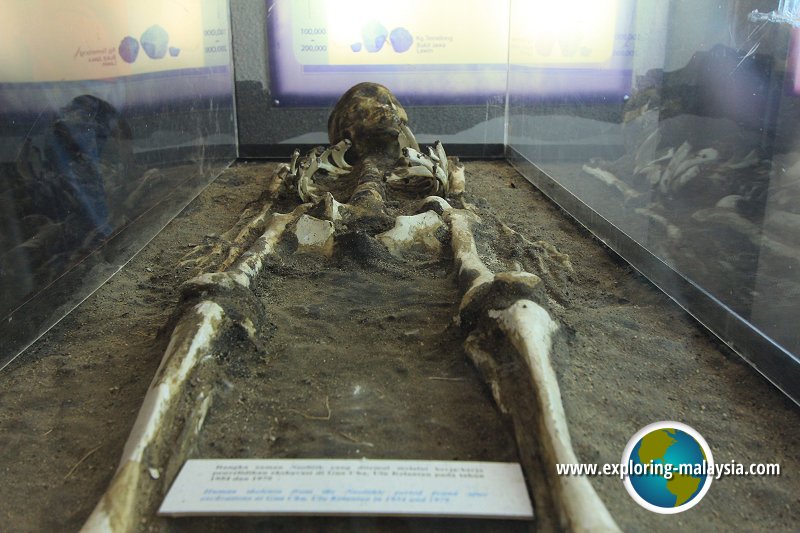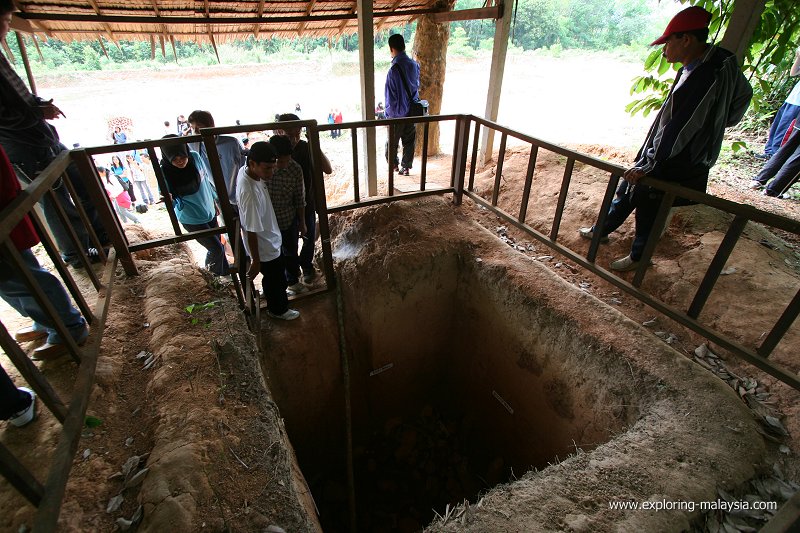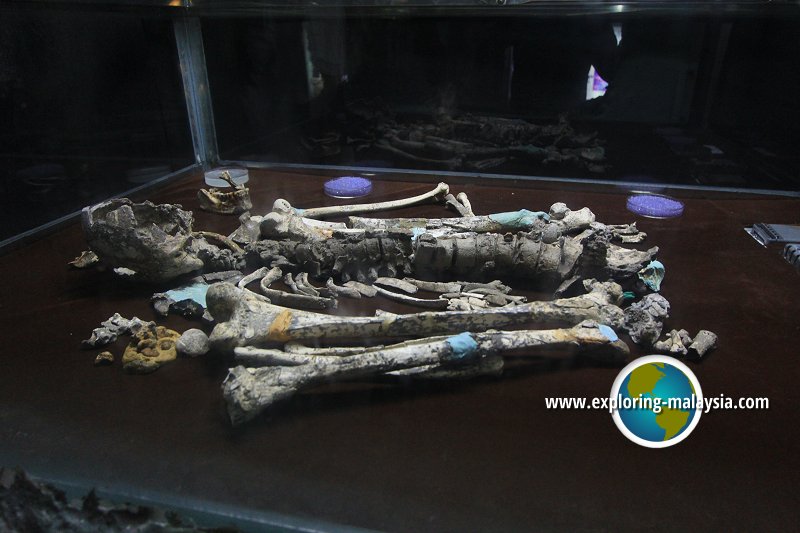 Lenggong Archaeological Museum (6 September, 2015)
Lenggong Archaeological Museum (6 September, 2015)
The Lenggong Archaeological Museum (GPS: 5.054317, 100.974040), also called Galeri Arkeologi Lembah Lenggong is a museum in Lenggong, Perak. Located on the eastern side of Sungai Perak, it showcases the archeological discoveries of Lenggong Valley. Lenggong Valley in Hulu Perak (Upper Perak) is where the earliest human settlement in Malaysia was discovered. Lenggong Valley is also the site where the longest prehistoric civilization in Malaysia was recorded, beginning in the Paleolithic Period (also written Palaeolithic, the scientific term for Stone Age) up to the Metal Period.
360° View of Geleri Arkeologi Lenggong on Google Maps Street View
Address
Lenggong Archaeological Museum Kota Tampan33400 Lenggong, Perak
Opens daily 9:00am-5:00pm, Fridays 9am-12:15pm, 2:45-5:00pm
Admission free
Lenggong Archaeological Museum is  on the map of Lenggong
on the map of Lenggong
Lenggong Valley Paleolithic Sites
About the Lenggong Archaeological Museum
The museum complex is located at the end of a road surrounded by palm oil plantation. It is in the form of an L-shaped building. The main portion of the museum has two storeys of galleries. On display are ancient stone tools that have been excavated. There are interpretive boards recounting the various paleolithic sites in the area such as Gua Harimau and Gua Gunung Runtuh.The highlight at the Lenggong Archaeological Museum are two human skeletons. The first is the remains from the Neolithic period that was found at Gua Cha in Ulu Kelantan, following excavations carried out in 1954 and 1979.
Perak Man
Details Human skeleton replica like those found in the limestone caves in Perak (6 September, 2015)
Human skeleton replica like those found in the limestone caves in Perak (6 September, 2015)
 Skeleton from Gua Cha in Kelantan (6 September, 2015)
Skeleton from Gua Cha in Kelantan (6 September, 2015)
 Neolithic human skeleton found at Gua Cha in Kelantan (6 September, 2015)
Neolithic human skeleton found at Gua Cha in Kelantan (6 September, 2015)
The star attraction has got to be Perak Man, which was finally brought back to the museum in 2014. I write more extensively about the Perak Man here.
About the archaeological sites in Lenggong Valley
The oldest site in the Lenggong Valley is Bukit Jawa, believed to be 300,000 years old (some documents placed the age as 50,000-100,000 years old). The second oldest is Kota Tampan, an open site with an age of 75,000 years (some documents 30,000-34,000 years old). Neither site yielded any human skeletal remains because the acidic soil is not favourable to preservation.Lenggong Valley is one of Malaysia's most important archaeological site. The sites where archaeological excavations are being carried out are still a rural area, with small Malay kampungs and fruit orchards. In addition to stone tools, Lenggong, like an open-air museum, has yielded cave drawings, prehistoric jewellery, pottery and weapons.
 Stone tools from different paleolithic sites in Lenggong (6 September, 2015)
Stone tools from different paleolithic sites in Lenggong (6 September, 2015)
The following are some of the archaeological sites in the Lenggong Valley and other sites in Perak:
Gua Harimau (Tiger Cave, 1000-4500 years old)
Gua Harimau is located in the Gua Harimau massif in Lenggong Valley, about 2km from the village of Kampung Gua Badak. Archaeological excation was carried out by the Malaysian Archaeological Research Centre of USM, with cooperations from the Department of Museums and Antiquities, in 1987, 1988 and 1995. 11 Neolithic-Bronze burials were discovered here. Mortuary objects placed with the skeleton included potteries, stone tools, bronze, iron, ornaments, hematite and food remains.
Gua Harimau helps us understand more about Malaysian prehistoric burials during the Neolithic-Bronze periods. The discovery of the bronze and its mould, dated to around 4500 years old, indicated that bronze craftmanship was not confined to the northern part of Thailand (Ban Chiang) alone.
Gua Kelawar (Bat Cave, 10,000 years old)
Gua Kelawar is located at Bukit Kepala Gajah, a limestone massif which also includes Gua Gunung Runtuh. Human habitation is evident here since 10000 years ago. Stone tools as well as edible shells indicated the area was used by nomadic tribes for as long as 1000 years.
Gua Gunung Runtuh (Cave of the Collapsing Mountain, 10000-11000 years old)
Gua Gunung Runtuh is the famous cave where the Perak Man was discovered.
Gua Bunuh (Cave of Murder, 50,000 years old)
Gua Bunuh is located about 1 km north of Kota Tampan in the Lenggong Valley. Gua Bunuh was discovered by the Malaysian Archaeological Research Centre of USM in January 2001. The site of Gua Bunuh covers a wide area of one square kilometer and was found to be a Paleolithic workshop. The findings at Bukit Bunuh helps us understand Malaysian history around 50,000 years ago, strengthening the theory that Hulu Perak (Upper Perak) was a site of human settlement in this region just as Java.
 A display of prehistoric stone carving tools (6 September, 2015)
A display of prehistoric stone carving tools (6 September, 2015)
Kota Tampan
Kota Tampan Paleolithic Site is located 6 km south of Lenggong town in Hulu Perak. Kota Tampan is one of the earliest archaeological research sites excavated by the Malaysian Archaeology Research Centre, USM, with cooperation of the Department of Museums and Antiquities. The discoveries at Kota Tampan makes it a benchmark for studies of stone age sties in the Southeast Asian region.
Although Kota Tampan was only excavated by the local research team in 1987, the first archaeological research carried out here was as early as 1938 by Collings. However, difficulties associated with dating and morphology made their findings controversial and evoked many problems.
In situ site findings by the Malaysian Archaeology Research Centre, USM, has helped to overcome the earlier problems. Excavations in 1987-1990 revealed that Kota Tampan was a stone age workshop dating as early as 50,000 years ago. They discovered that there was a stone age community living in the surrounding Lake Cenderoh.
Kampung Temelong
Kampung Temelong Paleolithic Site is located about 3 km from Lenggong town, and 1 km south of Bukit Jawa. The Kampung Temelong Paleolithic Site covers 300 sq m. The site was discovered in December 1990 and excavation research took place the same year by USM. So far, seven excavation trenches of one-meter square have been dug, exposing a stone age workshop for pebble tools. This site is related to that of Kota Tampan, and supports the theory of lake adaptation. Geological and archaeological evidence points to Kampung Temelong as dating as old as Bukit Jawa, which is 300,000 years old.
 Rock display outside Lenggong Museum (6 September, 2015)
Rock display outside Lenggong Museum (6 September, 2015)
Bukit Jawa
Bukit Jawa site is located in Kampung Gelok, about 7km north of Lenggong town. Although Bukit Jawa was discovered in the early 1990s, due to priorities to other projects, it was not excavated until July of 1996. The excavation at Bukit Jawa yielded over 150,000 pieces of stone artifacts from 24 excavation trenches there.
Research evidence places Bukit Jawa as the oldest Paleolithic site in Malaysia, besides Temelong and Lawin, all of which date to around 200,000-300,000 years ago. In addition, Bukit Jawa is the oldest undisturbed and in situ stone age site in Southeast Asia, confirming the belief that the Lenggong Valley is the oldest human settlement in Malaysia.
Gua Kelilawar Sungai Siput
Gua Kelilawar Sungai Siput is located at the west of an unnamed limestone massiff in Mukim Sungai Siput, Perak. The excavation at Gua Kelilawar was conducted by the Department of Museums and Antiquities, under Dr Adi Taha and Zulkifli Jaafar in 1986. The excavation revealed evidence of human occupation by hunters and gatherers from the Hoabinhian to the metal period. The findings included stone tools, food remains, riverine shells, bone tools, pottery and iron objects.
The cave was also occupied by the orang asli from the Negrito stock, as evident from the rock paintings on the wall. The main drawings depicted a human figure, abstracts, boat and animals.
Gua Singa and Gua Batu Putih
Gua Singa and Gua Batu Putih are both located in Hulu Perak, about 12 km north of Grik town. Excavations were carried out by the Malaysian Archaeology Research Centre, USM, in 1996.
Stone Slab Graves, Sungkai
The earliest stone slab graves in Lembah Bernam are located in Sungai Kruit Estate, Changkat Mentri in Sungkai, Perak. The slab graves are at present exhibited at the Perak Museum in Taiping. Archaeological studies in the Bernam Valley began as early as 1895, when J.A. Legge Junior, Perak Assistant Surveyor reported the find to L. Wray, the Curator of the Perak Museum.
In 1927, more stone slab graves were discovered by British archaeologists, in Sunagi Kruit and Sungai Bernam. Iron objects called "tulang mawas", pottery, bark cloth beater and beads were also found. Local archaeologists continued the research, and in 1992, Dr Leong Sau Heng of the University of Malaya, with cooperation from the Department of Museum and Antiquities, did a systematic excavation of Lembah Bernam. Nine stone slab graves were discovered, along with artifacts such as tulang mawas, pottery, bark cloth beater, bronzes and beads.
Kuala Selinsing
Kuala Selinsing is a coastal site located north of Perak. While early research work was done by I.H.N Evans in the 1920s and 30s, local archaeologists began digging here in 1998, led by Nik Hassan Shuhaimi of Universiti Kebangsaan Malaysia (UKM), and assisted by staff from the Department of Museums and Antiquities. The team concentrated their research on the islands of Pulau Buluh and Pulau Kelumpang, and discovered artifacts such as glass beads, bead making tools, a sunken boat, earthenware, human remains, food remains comprising different types of molluscs, fish and animal bones, turtle shell and metal objects.
The evidence suggested that Kuala Selinsing was populated from 200 BC to the 10th century. While we do not know whether the community made the artifacts, we do believe that it is a community that depends on the sea for their living.
Gua Badak Negito Cave Paintings
Gua Badak is a small cave located 1 km from the Lenggong Sumpitan main road, and 10 kn from Lenggong Town, in Hulu Perak. Research work by I.H.N. Evans suggested that the cave was used by the Negrito as late as the 1920s, who left their expressions in the form of cave paintings. Although quite recent, these paintings nevertheless provide a good pictorial example of art by a very primitive race. The paintings in black were executed in charcoal while those in white were done by scratching away the surface of the limestone rock. The subject of the paintings include a man carrying a pole laden with coconuts, with his monkey following behind. Bows and arrows depicted in the paintings also generated interest among the researchers. Another fascinating depiction was of motor cars, of a driving and steering wheels, evident that the Negritoes are exposed to the modern world.
Gua Tambun Prehistoric Rock Paintings
Gua Tambun is located in Tambun, 15 minutes outside of Ipoh. The site is along the main Tambun trunk road leading towards Tanjung Rambutan. The rock paintings, which were discovered in 1959, are said to be between 2000-5000 years old, and from the site, one can get a panoramic view of Ipoh City. To find the site, look for the Caltex petrol station along the main road, and take a small lane next to it. The lane leads to a polo field that ends at the limestone massif. The rock paintings are on a high ledge above the field.
The Tambun rock paintings depict images including humans in different postures, a human-like reptile, even the dugong, sea otter, dolphine-like monster, deer, tapir, wild boar and indecipherable abstract images.
Visit to Lenggong Archaeological Sites on 1 April 2006
My wife and I joined a contingent of archaeology students from the Universiti Sains Malaysia (USM), to Lenggong Valley on 1 April 2006. The trip was headed by a friend of ours, Dr Stephen Chia. We left Penang in two USM coaches at 7:30am, and stopped over for breakfast at Bukit Merah along the way. Many of us enjoyed nasi lemak bought by Yue Li, one of the AsiaExplorers members who volunteered to do the purchase. On this trip we were taken first to Bukit Jawa, where excavation revealed stone implements. Dr Stephen Chia giving us a briefing on how Stone Age people make tools (1 April, 2006)
Dr Stephen Chia giving us a briefing on how Stone Age people make tools (1 April, 2006)
Our next stop was Gua Gunung Runtuh, a 2 km trek from the main road. The first part of the trek was leisurely, as we walked through the Malay kampung and fruit orchards bearing mangosteen, durian, pomelos, among others. Then we had to climb up the hill towards the cave, and it was pretty tough, as the slope was wet and slippery, and the rocks towards to cave sharp and not firm. Nonetheless we managed to arrive at the cave - though I told myself I wouldn't want to come back for a repeat trip!
Gua Gunung Runtuh is the site where the famous Perak Man was discovered. It was just a small cave with openings at both ends. Dr Chia gave a briefing on the discovery of Perak Man. As the group was so large, there was hardly elbow room within the cave, and he had to explain to one group while the next had to wait outside the cave.
From Gua Gunung Runtuh, we proceeded to our lunch stop. Lunch was quite good, consisting of Malay buffet rice. Dishes included pineapple-and-fish yellow curry, beef dark curry, spicy fried fish, herb salad and accompanying spicy sauces, accompanied with rose syrup.
After lunch, we headed for the Lenggong Archaeological Museum, where we saw the replicas of Perak Man and other remains. There was an exhibition providing us details on the excavations being carried out in each of the sites in the Lenggong Valley.
Before heading back to Penang, we had a brief stopover at Tasik Raban for a rest. Tasik Raban is a recreational area along the way with lakeside pavilions offering scenic views. Dr Chia told us that Tasik Raban, which is joined to the Perak River. has receded since prehistoric age.
We arrived back at USM at 7:00pm that evening.
List of Museums in Malaysia
 Latest updates on Penang Travel Tips
Latest updates on Penang Travel Tips

Copyright © 2003-2025 Timothy Tye. All Rights Reserved.

 Go Back
Go Back



